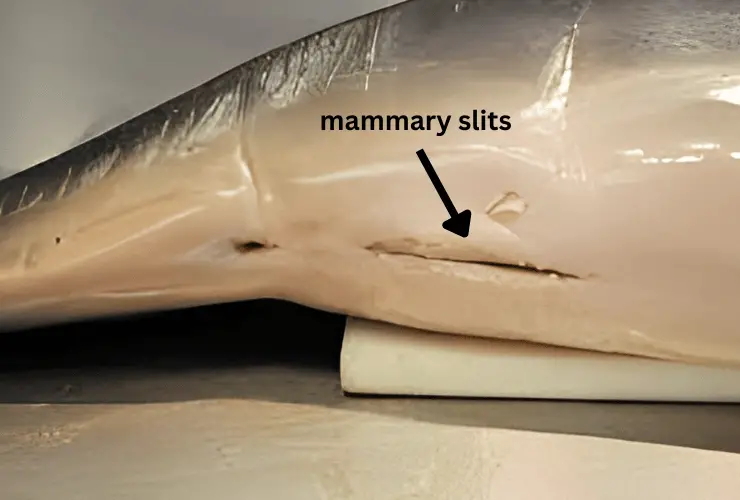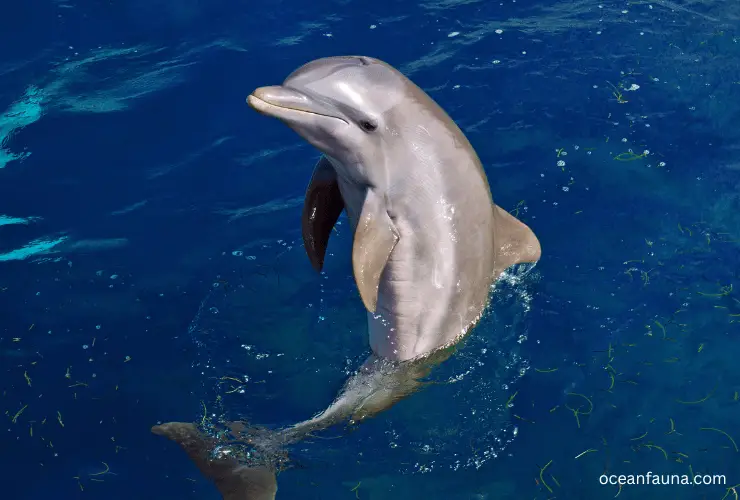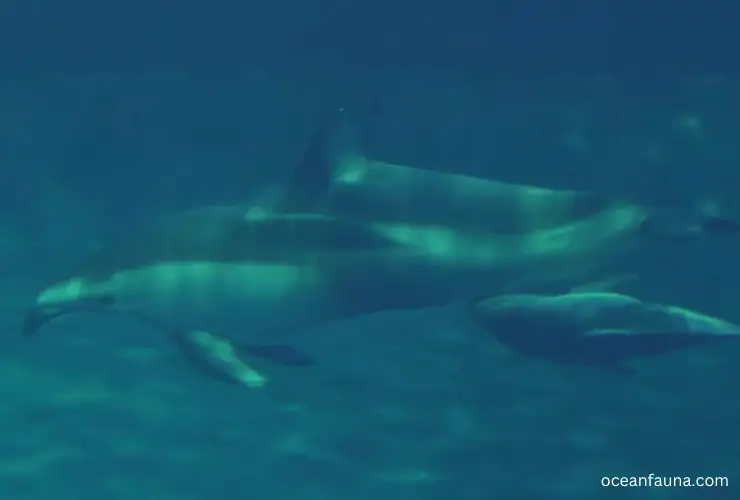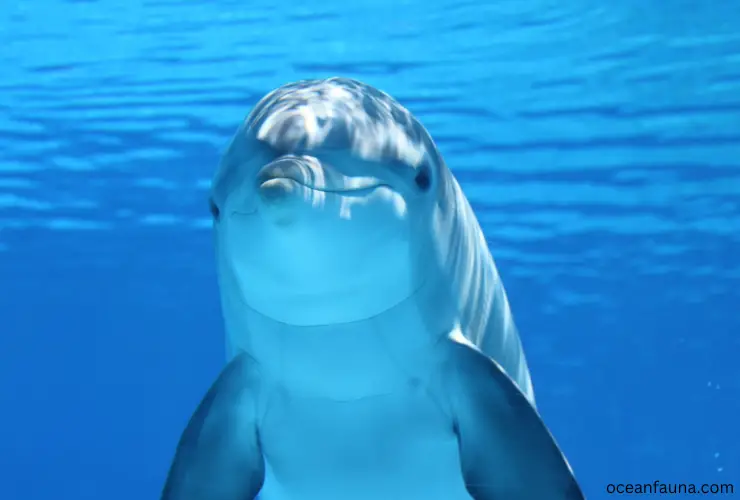Do dolphins have nipples?
As you know, dolphins are mammals. So, dolphins do have nipples, but not external like other mammals. Instead of external nipples, dolphins have mammary slits that run along the underside of their bodies. These slits contain small openings for milk to flow out, allowing them to nurse their young.
In this blog, I will discuss more detail on the nipples of dolphins. So read on to discover something new.

Do Dolphins Have Nipples?
Dolphins are aquatic mammals that differ significantly from land-based mammals’ morphology and physiology. The question that arises is whether dolphins have nipples or not. The answer is yes, but their nipples are less visible than land-based mammals.
Dolphins have mammary slits located near their genital regions, which contain their nipples. The mammary slit is an indentation in the skin that encloses the nipple. Regarding feeding, the calf uses tactile stimulation to expose the nipple through the mammary slit. The mother dolphin then positions herself to bring the nipple within reach of the calf’s mouth.
Unlike land-based mammals, where nipples are visible and milk is produced and delivered through them, dolphins have a unique feeding system since they live in aquatic environments. The nipple of the mother dolphin is only exposed when the calf initiates feeding.
In dolphins, the mammary gland is specialized to produce milk that is high in fat, which is crucial for the calf’s growth and development. It is also necessary to note that the milk production rate in dolphins is much higher than that of land-based mammals.
Do Boy Dolphins Have Nipples?
While it is true that male dolphins have two small pores located on either side of their genital-anal slit, which some scientists have hypothesized as possible vestigial nipples, it is important to note that these pores are not actually functional nipples.
Nipples serve a vital function in mammalian reproduction by providing a source of nourishing milk to offspring. However, as male dolphins do not lactate and therefore cannot produce milk, it follows that their nipples would also be nonfunctional.
In fact, male dolphins typically have smaller and less developed genital nipples compared to female dolphins, which are used for nursing their young. This further supports the idea that male dolphin nipples are not functional and are merely vestigial remnants of their evolutionary history.
What Do Dolphins’ Nipples Look Like?

Dolphin nipples are typically located between the pectoral fins on the belly of the dolphin. From a distance, they may appear as small bumps or raised spots; however, upon closer inspection, you can see that these are, in fact, nipples.
The size and shape of dolphin nipples vary depending on whether they belong to male or female dolphins. Female dolphins typically have larger and more developed nipples than male dolphins, which are used for nursing their young. On the other hand, male dolphin nipples are usually smaller and less developed.
Do Dolphins Produce Milk?
Yes, dolphins do produce milk to nurse their young. Like other mammals, dolphins have mammary glands that produce milk for their offspring. This milk is essential for the growth and development of young dolphins.
Dolphin milk is higher in fat content than the milk of other mammals. This is because dolphins need high energy to maintain their body temperature in cold ocean waters. The milk of dolphins contains around 35-50% fat, much higher than the milk of cows or humans.
Furthermore, the composition of dolphin milk is different from other mammals due to their unique diet and adaptations. Dolphins primarily feed on fish and squid, which makes their milk higher in certain nutrients such as omega-3 fatty acids and iodine. These nutrients are important for the healthy development of young dolphins’ brains and nervous systems.
Do Dolphins Breastfeed?
Yes, dolphins do breastfeed. Nursing is an essential component of dolphin reproduction. Dolphins are mammals, just like humans, and as such, they produce milk from mammary glands, as mentioned above, in order to feed their young.

Many people are surprised to learn that dolphins breastfeed their babies for an extensive period of time, sometimes up to a decade.
While some dolphins have been known to nurse their offspring for up to ten years, most of them nurse for a shorter period, typically between two to three years.
The milk produced by female dolphins is incredibly rich and fatty, essential for their young’s rapid growth and development. In comparison, human milk and cow’s milk have much lower levels of fat and nutrients.
Dolphin babies, commonly referred to as calves, grow extremely quickly due to the nutrient-dense milk they receive from their mothers.
This rapid growth and development are necessary for the calf’s survival in the wild, as they need to quickly learn how to swim, dive, hunt, and evade predators. Nursing also plays a critical role in the social bonding between mother and calf and between members of the larger dolphin pod.
How Many Nipples Do Dolphins Have?
Dolphins are mammals, which means they have mammary glands and produce milk for their offspring. In order to nurse, a dolphin calf must locate and attach to its mother’s nipples.
Female dolphins have two nipples that are located within the mammary slits near their belly. The nipples are inverted and only become erect when the calf latches on to form a firm grip around the teat. This latch provides the necessary stimulation for the mother to voluntarily eject milk for the calf to consume.
On the other hand, male dolphins do not have mammary glands and therefore do not have nipples that can produce milk. They have similar mammary slits, but they are shaped like an exclamation point and serve no purpose in nursing. Instead, male dolphins are needed for mating purposes and do not have any role in nurturing or feeding their offspring.
How Do Dolphins Reproduce?

Dolphins have a unique reproductive system. They reproduce through internal fertilization, which requires the male dolphin to hook onto the female to ensure reproductive success. This process is also known as copulation.
The reproduction system of dolphins starts with mating, which occurs all year round in the wild and can last for hours. During copulation, the male dolphin releases sperm into the female’s reproductive tract. The fertilization occurs when the sperm meets the egg, which is located in the female’s ovaries. The eggs move down the female’s oviducts while the sperm swim towards the egg. Once they come in contact, the sperm penetrates the egg, fertilizing it.
After fertilization, the egg cell develops into a zygote, gradually growing into an embryo. The embryo is nourished by the mother’s placenta, a specialized fetal organ connecting the developing fetus to the mother’s uterus. The pregnancy or gestation period can last approximately a year.
Female dolphins give birth to one calf every 3 to 5 years, which is a relatively long period for a mammal. The calf’s birth takes place underwater, and the mother must bring the baby to the surface for its first breath. At birth, the calf is about 3 to 4 feet long and weighs around 40 to 50 pounds.
Nursing is crucial for the calf’s survival, and they depend on the mother’s milk for the first few months of their life. The weaning process takes place gradually as the calf becomes more independent and eats solid food.
Conclusion
Hopefully, you clearly know dolphins’ nipples, breastfeeding, and reproduction system. If you have further queries, do not hesitate to ask.

